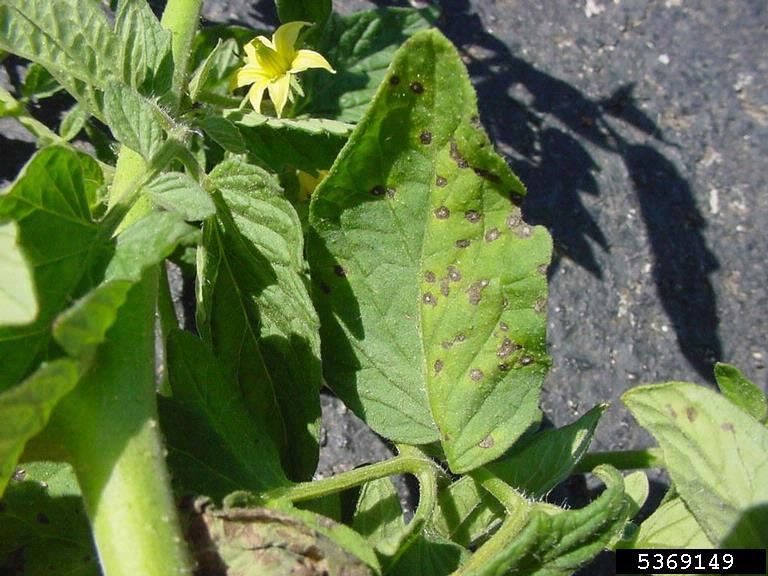Marissa Schuh, IPM Extension Educator, mschuh@umn.edu
Tomato might be the spottiest vegetable we grow – there are many diseases that can cause leaf spots, and they can all look very similar. Some of the diseases are caused by bacteria, some are caused by fungi. This means that some of the same cultural practices may work, but if you are thinking about chemical controls and longer term management, knowing which pathogen you have will be important.
Fungal pathogens
We have two fungal diseases we commonly see causing leaf spots in Minnesota – early blight and septoria leaf spot.
Early blight is very common. The pathogen survives in crop debris and weeds, then infects plants by splashing up into the foliage. This means that the first part of the plant infected is the oldest leaves. Infected leaves develop brown spots, and if you look closely at these spots, there will be concentric rings inside of them. These spots can become large, and can join together and kill entire leaves.

Septoria leaf spot is a disease we often start to see a little later in the season, as fruit starts to set. This disease causes many small spots on the leaves, starting on the lowest leaves. These spots may develop tan centers.
 Septoria leaf spot causes many small leaves, these often have a tan center. Photo: Paul Bachi, University of Kentucky Research and Education Center, Bugwood.org
Septoria leaf spot causes many small leaves, these often have a tan center. Photo: Paul Bachi, University of Kentucky Research and Education Center, Bugwood.org
When it comes to fungicides, there are both conventional and organic products available. Remember these products are preventative, so the best time to treat is when you are seeing just a hint of disease. See the Midwest Vegetable Production Guide for products and more information.
Chemical controls for these bacterial pathogens is a little trickier than for fungal diseases. Copper is one of our main tools, but different strains of bacterial spot are resistant to copper. There are still some conventional and organic products available, as always, check the Midwest Vegetable Production Guide.
Early blight attacks the oldest leaves first. Photo: Gerald Holmes, Strawberry Center, Cal Poly San Luis Obispo, Bugwood.org
Fungal pathogens
We have two fungal diseases we commonly see causing leaf spots in Minnesota – early blight and septoria leaf spot.
Early blight is very common. The pathogen survives in crop debris and weeds, then infects plants by splashing up into the foliage. This means that the first part of the plant infected is the oldest leaves. Infected leaves develop brown spots, and if you look closely at these spots, there will be concentric rings inside of them. These spots can become large, and can join together and kill entire leaves.
Early blight causes larger, amorphous brown spots with concentric rings. Photo: Gerald Holmes, Strawberry Center, Cal Poly San Luis Obispo, Bugwood.org
Septoria leaf spot is a disease we often start to see a little later in the season, as fruit starts to set. This disease causes many small spots on the leaves, starting on the lowest leaves. These spots may develop tan centers.
Things that can be done now: catch up on staking and tying. This helps plants dry out quickly, making the environment less hospitable to fungi. You can also prune off infected leaves. Weeding also helps with airflow.
When it comes to fungicides, there are both conventional and organic products available. Remember these products are preventative, so the best time to treat is when you are seeing just a hint of disease. See the Midwest Vegetable Production Guide for products and more information.
Bacterial pathogens
Bacterial diseases are caused by a different type of pathogen. These bacterial pathogens likely first enter the farm on infected seeds and transplants, then hang around in weeds, plant debris, and on tools and other production surfaces. The excess moisture we've had in some parts of the state have created conditions where these pathogens can move from plant to plant easily.Bacterial spot is a disease we see both in pepper and tomatoes. Infected leaves have small (less than 1/8 inch), brown, circular spots surrounded by a yellow halo. The center of the leaf spots often falls out resulting in small holes. There will be no concentric rings in these spots.
Bacterial leaf spot. Edward Sikora, Auburn University, Bugwood.org
Bacterial speck looks similar. Spots are small and darkly colored, though they are more noticeable on the lower side of the leaf. When infection starts, there won't be yellow halos, but as time progresses, halos appear, and spots can join together.
Okay, but I can't identify my leaf spots...
If you have lots of plants with lots of spots, getting a sample to the Plant Disease Clinic is the best course of action. Samples tend cost around $50, but can give you the specific disease ID you need to do effective long term and short term management. See their website for forms and sample submission guidelines.
.jpg)

Comments
Post a Comment